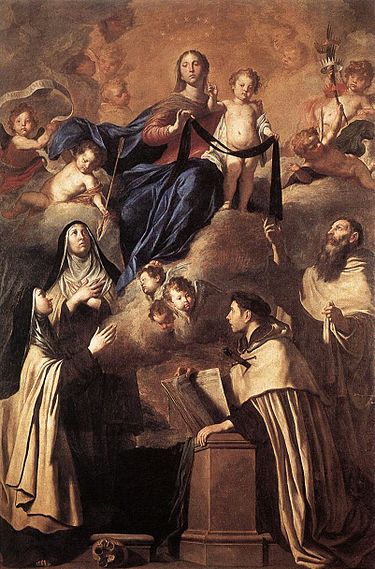
MAY 16 is the traditional memorial of ST. SIMON STOCK (+1265). Little about St. Simon comes from contemporary records. Much was written one hundred years, or more, later and it is hard to distinguish which is real and which is elaborated.
What we do know is that Simon was English and probably born in Kent, the area bordering the English Channel, around 1165. He was an ascetic and lived as a hermit for years. He lived on a diet of roots, herbs, wild apples and water. The story is that he became a hermit at 12 and lived in a hallowed out oak tree (a stock). Hence his surname.
Around 1205, the patriarch of Jerusalem, Albert, had given a written rule to men dedicated to Our Lady of Mount Carmel. A few years later, a group of Englishmen returned from one of the Crusades. These men had dedicated their lives to the rule of Carmelite friars and took to the woods of Kent to pray and serve. Simon was drawn to them and, by the end of 1212, had joined them. He was sent to Oxford to continue his studies and returned in two years, exhibiting his knowledge and sanctity. In 1215, he was nominated vicar-general for the western provinces.
However, many secular clergy and other orders were not encouraged by these contemplative monks and made trouble for them. To counter this, Simon went to Rome in 1226 and received approval of Albert’s rule from both Pope Honorius III (1227) and Pope Gregory IX (1229).
A few years later, Simon went to Palestine to visit the Carmel. He spent six years there, where he assisted at the general chapter meeting in 1236. Due to continued onslaught of Muslim attackers, it was decided to send the majority of the friars to western Europe. So, beginning in 1240, many moved to England. By 1245, the order in England had grown quite large and Simon, by this time 80 years old, was elected to be prior general.
Under Simon’s leadership, the Carmelite order flourished, founding convents in university cities of Cambridge, Oxford, Paris and Bologna. This was in keeping with the concept of expansion so that the young novices could be easily educated.
The difficulties of oppression by secular clergy and others continued. The entire Carmelite body, devoted to the Blessed Virgin, prayed for a singular privilege for the order so that it would be saved. It is said that on July 16, 1251, she appeared to Simon, holding a small scapular. Not only did she insist that those who wore the scapular (persevered in their vocation) would be saved, but she also suggested that Simon apply for a letter of protection from Pope Innocent IV. Simon went, again, to Rome and received this letter on January 13, 1252. Today, the scapular is used throughout the world as a symbol of dedication to Our Lady of Mount Carmel, used along with the accompanying prayers and devotions. The Carmelites continued to expand.
St. Simon died May 16, 1265, probably in Bordeaux, France, where he was buried. Over the years, his relics have been divided up among several convents and churches.
July 16 is the feast of Our Lady of Mount Carmel.
“This shall be a privilege unto thee and all Carmelites; he who dies in this habit shall be saved.” — Blessed Virgin to St. Simon on presenting him a scapular of the order

Recent Comments